The Health Education Assets Library (HEAL) is a collection of over 22,000 freely available digital materials for health sciences education. The collection is now housed at the University of Utah J. Willard Marriott Digital Library.
TO
Filters: Collection: "ehsl_heal"
| Title | Description | Subject | Collection | ||
|---|---|---|---|---|---|
| 251 |
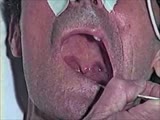 |
Cranial Nerve Exam: Abnormal Examples: Cranial Nerves 9 & 10 - Motor | When the patient says ah there is excessive nasal air escape. The palate elevates more on the left side and the uvula deviates toward the left side because the right side is weak. This patient has a deficit of the right 9th & 10th cranial nerves. Video courtesy of Alejandro Stern, Stern Foundation. ... | Cranial Nerve Examination | NeuroLogic Exam: An Anatomical Approach |
| 252 |
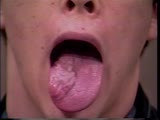 |
Cranial Nerve Exam: Abnormal Examples: Cranial Nerve 12 - Motor (x2) | Notice the atrophy and fasciculation of the right side of this patient's tongue. The tongue deviates to the right as well because of weakness of the right intrinsic tongue muscles. These findings are present because of a lesion of the right 12th cranial nerve. NeuroLogic Exam has been supported by a... | Cranial Nerve Examination | NeuroLogic Exam: An Anatomical Approach |
| 253 |
 |
Cranial Nerve Exam: Abnormal Examples: Cranial Nerve 12 - Motor | Notice the atrophy and fasciculation of the right side of this patient's tongue. The tongue deviates to the right as well because of weakness of the right intrinsic tongue muscles. These findings are present because of a lesion of the right 12th cranial nerve. NeuroLogic Exam has been supported by a... | Cranial Nerve Examination | NeuroLogic Exam: An Anatomical Approach |
| 254 |
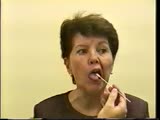 |
Cranial Nerve Exam: Abnormal Examples: Cranial Nerve 7 - Sensory, Taste | The patient has difficulty correctly identifying taste on the right side of the tongue indicating a lesion of the sensory limb of the 7th nerve. NeuroLogic Exam has been supported by a grant from the Slice of Life Development Fund at the University of Utah, the Department of Pediatrics and the Offic... | Cranial Nerve Examination | NeuroLogic Exam: An Anatomical Approach |
| 255 |
 |
Coordination Exam: Anatomy: Midline Ataxia (includes Spanish audio & captions) | Clinically, the ataxic syndromes caused by vestibulocerebellar and spinocerebellar disease are lumped together and are called midline or equilibratory (gait) ataxias. The hallmarks of these midline ataxic syndromes are truncal instability manifested by titubation (tremor of the trunk in an anterior-... | Coordination Examination; Anterior Lobe of Cerebellum; Flocculonodular Lobe | NeuroLogic Exam: An Anatomical Approach |
| 256 |
 |
Coordination Exam: Abnormal Examples: Speech - Rapid Alternating Movements - Dysarthria (x2) (includes Spanish audio & captions) | Impaired speech articulation of cerebellar origin is characterized by being slow, indistinct, and scanning (scanning refers to decomposition of words into monosyllabic parts and loss of normal phrasing and intonation). NeuroLogic Exam has been supported by a grant from the Slice of Life Development ... | Coordination Examination | NeuroLogic Exam: An Anatomical Approach |
| 257 |
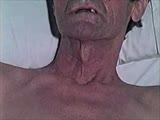 |
Cranial Nerve Exam: Abnormal Examples: Cranial Nerve 11 - Motor | When the patient contracts the muscles of the neck the left sternocleidomastoid muscle is easily seen but the right is absent. Looking at the back of the patient, the left trapezius muscle is outlined and present but the right is atrophic and hard to identify. These findings indicate a lesion of the... | Cranial Nerve Examination | NeuroLogic Exam: An Anatomical Approach |
| 258 |
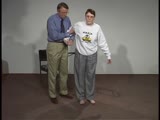 |
Coordination Exam: Abnormal Examples: Station (x2) (includes Spanish audio & captions) | Patient's feet will be placed wider apart then usual in order to maintain balance (broad or wide-based station). Midline ataxias cause instability of station with eyes opened or closed. NeuroLogic Exam has been supported by a grant from the Slice of Life Development Fund at the University of Utah, t... | Coordination Examination; Station | NeuroLogic Exam: An Anatomical Approach |
| 259 |
 |
Coordination Exam: Abnormal Examples: Hand - Rapid Alternating Movements (x2) (includes Spanish audio & captions) | Movements are slow and irregular with imprecise timing. Inability to perform repetitive movements in a rapid rhythmic fashion is called dysdiadochokinesia. NeuroLogic Exam has been supported by a grant from the Slice of Life Development Fund at the University of Utah, the Department of Pediatrics an... | Coordination Examination; Dysdiadochokinesia | NeuroLogic Exam: An Anatomical Approach |
| 260 |
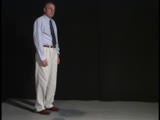 |
Gait Exam: Abnormal Examples: Hemiplegic Gait Demonstration | The patient has unilateral weakness and spasticity with the upper extremity held in flexion and the lower extremity in extension. The foot is in extension so the leg is too long therefore, the patient will have to circumduct or swing the leg around to step forward. This type of gait is seen with a U... | Gait Examination; Hemiplegic Gait | NeuroLogic Exam: An Anatomical Approach |
| 261 |
 |
Coordination Exam: Abnormal Examples: Natural Gait (x2) (includes Spanish audio & captions) | Wide-based, unsteady, irregular steps with lateral veering| ataxia is most prominent when sudden changes are needed such as turning, standing up or stopping. NeuroLogic Exam has been supported by a grant from the Slice of Life Development Fund at the University of Utah, the Department of Pediatrics ... | Coordination Examination; Natural Gait | NeuroLogic Exam: An Anatomical Approach |
| 262 |
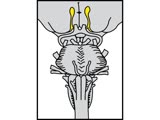 |
Cranial Nerve Exam: Anatomy: Cranial Nerve 1 (x2) | Olfaction is the only sensory modality with direct access to cerebral cortex without going through the thalamus. The olfactory tracts project mainly to the uncus of the temporal lobes. NeuroLogic Exam has been supported by a grant from the Slice of Life Development Fund at the University of Utah, th... | Cranial Nerve Examination | NeuroLogic Exam: An Anatomical Approach |
| 263 |
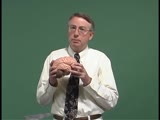 |
Coordination Exam: Anatomy: Introduction (x2) (includes Spanish audio & captions) | The principle area of the brain that is examined by the coordination exam is the cerebellum. The cerebellum is important for motor learning and timing of motor activity. It fine-tunes the force of agonist and antagonist muscle activity simultaneously and sequentially across multiple joints to produc... | Coordination Examination | NeuroLogic Exam: An Anatomical Approach |
| 264 |
 |
Cranial Nerve Exam: Abnormal Examples: Cranial Nerves 2 & 3 - Pupillary Light Reflex (x2) | The swinging flashlight test is used to show a relative afferent pupillary defect or a Marcus Gunn pupil of the left eye. The left eye has perceived less light stimulus (a defect in the sensory or afferent pathway) then the opposite eye so the pupil dilates with the same light stimulus that caused c... | Cranial Nerve Examination; Marcus Gunn Pupil | NeuroLogic Exam: An Anatomical Approach |
| 265 |
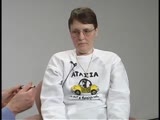 |
Coordination Exam: Abnormal Examples: Finger-to-nose (includes Spanish audio & captions) | Under (hypometria) and over (hypermetria) shooting of a target (dysmetria) and the decomposition of movement (the breakdown of the movement into its parts with impaired timing and integration of muscle activity) are seen with appendicular ataxia. NeuroLogic Exam has been supported by a grant from th... | Coordination Examination; Finger-to-nose Test | NeuroLogic Exam: An Anatomical Approach |
| 266 |
 |
Coordination Exam: Abnormal Examples: Station (includes Spanish audio & captions) | Patient's feet will be placed wider apart then usual in order to maintain balance (broad or wide-based station). Midline ataxias cause instability of station with eyes opened or closed. NeuroLogic Exam has been supported by a grant from the Slice of Life Development Fund at the University of Utah, t... | Coordination Examination; Station | NeuroLogic Exam: An Anatomical Approach |
| 267 |
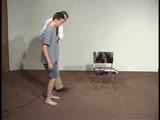 |
Coordination Exam: Abnormal Examples: Tandem Gait (includes Spanish audio & captions) | Patients with ataxia have difficulty narrowing the station in order to walk heel to toe. Tandem gait is helpful in identifying subtle or mild gait ataxia. NeuroLogic Exam has been supported by a grant from the Slice of Life Development Fund at the University of Utah, the Department of Pediatrics and... | Coordination Examination; Tandem Gait; Heel-toe Gait | NeuroLogic Exam: An Anatomical Approach |
| 268 |
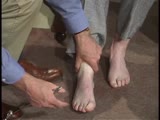 |
Coordination Exam: Abnormal Examples: Foot - Rapid Alternating Movements (x2) (includes Spanish audio & captions) | Movements are slow and irregular with imprecise timing of agonist and antagonist muscle action. NeuroLogic Exam has been supported by a grant from the Slice of Life Development Fund at the University of Utah, the Department of Pediatrics and the Office of Education at the University of Nebraska Medi... | Coordination Examination; Rapid Alternating Movements; Adiadochokinesis | NeuroLogic Exam: An Anatomical Approach |
| 269 |
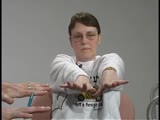 |
Coordination Exam: Abnormal Examples: Rebound (x2) (includes Spanish audio & captions) | Increased range of movement with lack of normal recoil to original position is seen in cerebellar disease. NeuroLogic Exam has been supported by a grant from the Slice of Life Development Fund at the University of Utah, the Department of Pediatrics and the Office of Education at the University of Ne... | Coordination Examination; Rebound | NeuroLogic Exam: An Anatomical Approach |
| 270 |
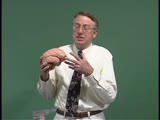 |
Gait Exam: Anatomy: Introduction | All levels of the neuroaxis contribute to gait although most gait abnormalities are motor in nature. In assessing gait it is important to not only watch the lower extremities but also the upper extremities for normal associated movements. NeuroLogic Exam has been supported by a grant from the Slice ... | Gait Examination | NeuroLogic Exam: An Anatomical Approach |
| 271 |
 |
Coordination Exam: Abnormal Examples: Rebound (includes Spanish audio & captions) | Increased range of movement with lack of normal recoil to original position is seen in cerebellar disease. NeuroLogic Exam has been supported by a grant from the Slice of Life Development Fund at the University of Utah, the Department of Pediatrics and the Office of Education at the University of Ne... | Coordination Examination; Rebound | NeuroLogic Exam: An Anatomical Approach |
| 272 |
 |
Cranial Nerve Exam: Anatomy: Major Oculomotor Gaze Systems (x2) | Eye movements are controlled by 4 major oculomotor gaze systems, which are tested for on the neurological exam. They are briefly outlined here: Saccadic (frontal gaze center to PPRF (paramedian pontine reticular formation) for rapid eye movements to bring new objects being viewed on to the fovea. Sm... | Cranial Nerve Examination | NeuroLogic Exam: An Anatomical Approach |
| 273 |
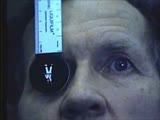 |
Cranial Nerve Exam: Abnormal Examples: Cranial Nerves 3, 4 & 6 - Ductions (x2) | Each eye is examined with the other covered (this is called ductions). The patient is unable to adduct either the left or the right eye. If you watch closely you can see nystagmus upon abduction of each eye. When both eyes are tested together (testing versions) you can see the bilateral adduction de... | Cranial Nerve Examination; Ductions | NeuroLogic Exam: An Anatomical Approach |
| 274 |
 |
Cranial Nerve Exam: Anatomy: Major Oculomotor Gaze Systems | Eye movements are controlled by 4 major oculomotor gaze systems, which are tested for on the neurological exam. They are briefly outlined here: Saccadic (frontal gaze center to PPRF (paramedian pontine reticular formation) for rapid eye movements to bring new objects being viewed on to the fovea. Sm... | Cranial Nerve Examination | NeuroLogic Exam: An Anatomical Approach |
| 275 |
 |
Gait Exam: Anatomy: Localizing Value | There are 7 basic pathological gaits that should be recognized by their characteristic pattern. These pathological gaits are: - Hemiplegic - Spastic diplegic - Neuropathic - Myopathic - Parkinsonian - Chorea - Ataxic These gaits have localizing value because they can indicate levels (an y axis a... | Gait Examination; Hemiplegic Gait; Spastic Diplegia; Neuropathic Gait; Myopathic Gait; Diplegic Gait | NeuroLogic Exam: An Anatomical Approach |
